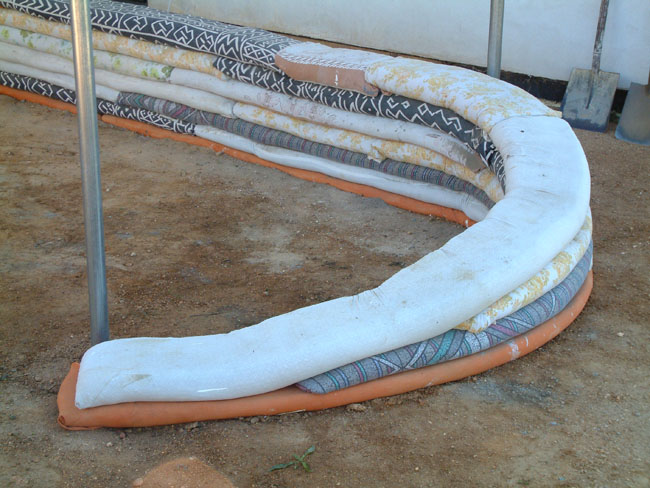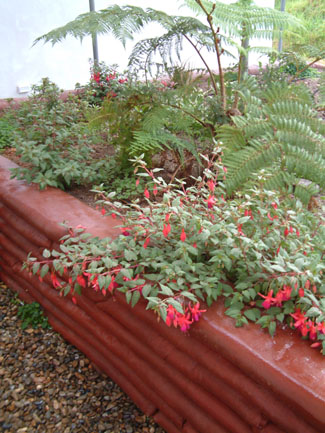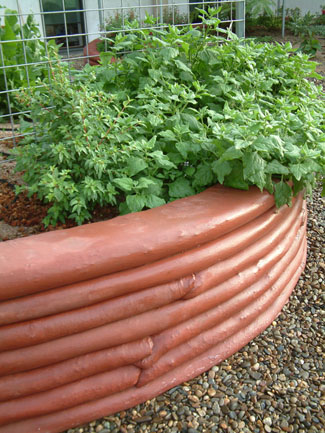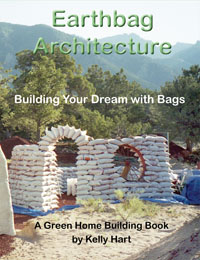We were looking for an easy, cheap and relatively quick method of building a wall to create a raised garden bed. We first read about earth bag building in an Owner Builder magazine years ago. A quick search on the Internet found us lots of examples and plenty of basic instructions. It looked ideal so we gave it a go.

Earth bag building is essentially rammed earth in a fabric form. There is a wide range of materials the bags can be made from depending on what you can get your hands on - hessian, old feed bags or, in our case, old sheets. Any required sewing is a straight forward job (no pun intended) that can be done in the evenings or on rainy days.
You don't need to be a muscle man to use this technique as the materials are mixed and loaded into the bags while dry. The bags can be filled in place on the wall, which means no heavy lifting is required. You can fill the bags spoonful by spoonful if you want.
The finished look of the wall is up to you. You can leave it alone and eventually the fabric will rot off. Or you can help the processes along and burn the fabric off after the wall is set. Or you can paint, render or plaster over the finished wall. The choice is up to you.

Our passive solar strawbale house has a protected courtyard on the southern side. Its purpose is to provide a cool zone for 'airconditioning' the house in summer. In the evening the south windows can be opened to draw in the cooler air and the warmer interior air flushed out the north side. For this to work the courtyard needs to be landscaped appropriately - it certainly didn't work last summer when the courtyard was a bare patch of dirt. We expect it will take several years for the plants to grow enough for the effect to work as planned. In order to provide a good growing environment for the plants we needed to create raised beds.
As we used scrap material provided out of rag bags of family and friends. Our only cost for the walls was $260 on cement to stabilise the walls. With this we built 10 square metres of wall using bags adding up to a total of about 200 metres long. We used about 8 tonnes of subsoil.
On the labour side it took the two of us about 3 days of work to build the walls, ignoring the preparation time sewing the bags. I don't know how long it took to assemble all the bags as other family members provided some of the contributed material already sewn into bags. I was quite surprised at that managed 200 metres of bags without resorting to purchasing any fabric, although it took us about a month to organise it all.
We could have worked harder when building the walls and another set of hands would have made the work go even more quickly. As we chose to use really long bags and fill them in place on the wall it took two sets of hands to fill the bags - one to hold the bag and funnel and another to shovel. A system with smaller bags could be setup if it needed to be a one person operation.
First let me say neither of us are structural engineers so you will need to get your own advice for any project you undertake. You will also need to get any required Council approvals. That said, this method of construction provided us with a stable wall quite easily. The commonsense things we did to make sure it was stable were:
- Made the bags 30cm wide. This resulted in a wall about 25cm wide with each course being about 5cm high.
- Thought about the footing under the wall and made sure it was stable.
- Put in place required drainage under the wall and left weep holes in lower courses.
- Stabilised the earth (decomposed granite subsoil excavated from our house building site) with cement at a 1:10 ratio. We also made sure no stray organic matter (weeds, sticks etc) that would rot out and leave gaps ended up in the mix.
- Lightly filled the lowest bags. This made them slightly wider than higher courses, giving us a slightly tapered wall.
- Tamped each layer of bags very firmly.
- Put plenty of curves in the design so that bracing is provided by the wall itself. If we had wanted a long straight run we would probably have had to buttress it in some way.
- Not build it too high. The wall is only about half a metre high. The bonus to this is is makes a nice seat around the edge of the garden bed.
There are a range of methods that people have used to improve the strength and stability of earth bag walls. Some examples for locking the courses together include running lengths of barbed wire between the courses or hammering lengths of rebar down through the courses once they are laid. We didn't use any of these for our low garden wall. We would have considered these methods if we had been trying to build a higher wall.
 
Right after we finished building the walls we were lucky enough to get plenty of rain. This helped provide the moisture required for the walls to set. In hot dry weather we might have needed to water the walls regularly to get the same result.
We decided we couldn't wait for the fabric to rot naturally off the walls so we painted them with a cement oxide mixture using the recipe for petrified hessian from Alanna Moore's Backyard Poultry - Naturally book. We added red oxide to the mix until we liked the depth of colour. The result looks similar to using a limewash and sets quite hard.
Now that the raised garden beds have been filled with soil and planted out the courtyard is starting to look green . It will probably take another year for the plantings to fill out and fulfill our vision for the space, but the retaining walls are already a success. We're now planning new projects to take advantage of our newly developed earth bag skills.
|




